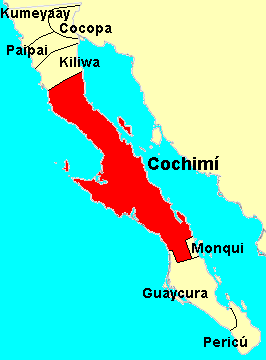Cochimí facts for kids
The Cochimí were a group of Native people who lived in the middle part of the Baja California peninsula in Mexico. Their land stretched from El Rosario in the north to San Javier in the south. We know about their way of life and beliefs mostly from early explorers and especially from the writings of Jesuit missionaries. Important records come from people like Miguel Venegas and Miguel del Barco.
Contents
History of the Cochimí People
The Cochimí first met Spanish explorers in the 1500s. Famous explorers like Ulloa, Cabrillo, and Vizcaíno sailed along the coast. These meetings happened now and then until the late 1600s, when the Jesuits started building missions in the area.
Missions and Changes
Eusebio Francisco Kino tried to start a mission called San Bruno in 1683, but it didn't last. In 1697, Juan María de Salvatierra successfully started the first mission at Loreto. This mission was for the Monqui people, who were neighbors of the Cochimí.
Soon after, in 1699, Francesco Maria Piccolo started a mission for the Cochimí at San Javier. Over the next 70 years, more missions were built further north. These included:
- Mulegé (1705)
- Comondú (1708)
- La Purísima (1720)
- Guadalupe (1720)
- San Ignacio (1728)
- Santa Gertrudis (1751)
- San Borja (1762)
- Santa María (1767)
After the Jesuits
In 1768, the Spanish government told the Jesuits to leave Baja California. The Franciscans took over, led by Junípero Serra. They built another mission, San Fernando Velicatá (1769), as they traveled north.
Later, the Dominicans came to Baja California. They built the last mission for the Cochimí at El Rosario (1774).
Sadly, many Cochimí people became sick from diseases brought by the Europeans, like smallpox. Their population greatly decreased. Because of this, their language and traditional way of life eventually disappeared in the 1800s or early 1900s.
Cochimí Culture and Lifestyle
The Cochimí were hunter-gatherers. This means they found their food by hunting animals and gathering plants. They did not farm or work with metals. They lived a simple life that fit their dry environment and their need to move around often.
Their communities were independent, and groups often had conflicts. Some of their unique cultural practices included:
- The Maroma: This was a special way of sharing food. A piece of meat was tied to a string, swallowed, and then pulled back up. It was then passed to the next person in a circle. This continued until the meat was completely gone.
- Tablas: These were wooden tablets with painted designs or holes drilled into them. They were used in religious ceremonies. Archaeologists have found some of these old tablets.
- Human-Hair Capes: Shamans, who were spiritual leaders, wore capes made from human hair during special ceremonies. People would donate their hair to make these capes.
Cochimí Language
The Cochimí people spoke different dialects, or versions, of a language. These dialects were very similar to each other. The main difference was between Northern Cochimí and Southern Cochimí, with the dividing line usually south of San Ignacio.
Their language is related to the Yuman languages spoken in northern Baja California, southern California, and western Arizona. However, experts like Mauricio J. Mixco believe that Cochimí is not directly part of the Yuman family. Instead, it's like a sister language, forming a larger group called the Yuman–Cochimí family.
See also
 In Spanish: Cochimí para niños
In Spanish: Cochimí para niños


